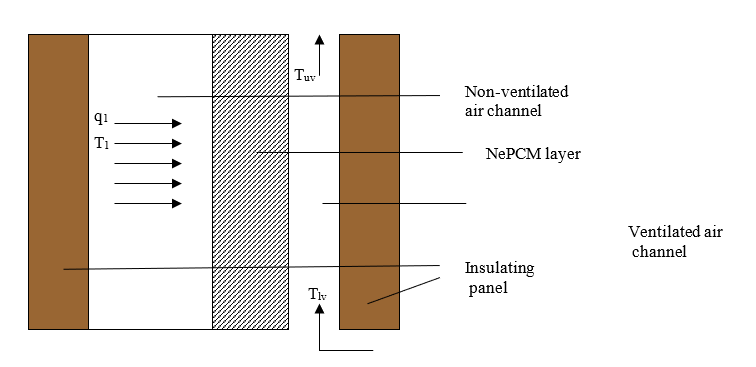Two-Dimensionalnumerical Study of the Effect of Nanoparticles on the Fusion and Freezing Process of Phase Change Materials Using a Computing Method
Main Article Content
Abstract
In this paper, a scalar two-dimensional analysis was conducted on the influence of nanoparticles on the thawing and freezing rate of phase-change materials based on enthalpy method that is an innovative calculation method. To this end, carbon nanotubes (CNTs) and aluminum oxide nanoparticles (NPs) were employed as a model of cylindrical and spherical nanoparticles, respectively.Paraffin and a composite of hydrated salts was also utilized as the PCM. The numerical procedure involved the simulation of the phase change process based on finite difference using enthalpy approach. Because of the recent innovations in computer calculation and also its connection with mechanical engineering a computational code was written for this purpose.
Simulation results indicated a reduction in time of thawing and freezing upon incorporation of nanoparticles into the phase change material. For both states, CNTs showed the better result due to acceleration of the heat transfer. The biggest increase (28%) in the rate of thawing and freezing was for CNT-paraffin system; while the lowest increase (6%) was observed in aluminum oxide-hydrated salt system. This result can be utilized to control the speed of energy storage and release.
Article Details
References
Mashhour A.Alazwari, MohammedAlgarni, Mohammad RezaSafaei,“Effects of various types of nanomaterials on PCM melting process in a thermal energy storage system for solar cooling application using CFD and MCMC methods,”International Journal of Heat and Mass Transfer.Volume 195, October 2022, 123204.
Ao. Li, Shuangping. Duan, Rubing. Han, Chaoyu. Wang, “Investigation on the dynamic thermal storage/release of the integrated PCM solar wall embedded with an evaporator,”Renewable Energy, Available online 4 October 2022
S.S.Sebti, SH.Khalilarya, I.Mirzaee, S.F. Hosseinizadeh, S.Kashani ,M.Abdollahzadeh“,A Numerical Investigation of solidification in Horizontal Concentric Annuli Filled with Nano-Enhanced Phase change Material (NEPCM),” World Applied Sciences Journal 13 (1), 09-15, 2011
S. Kashani, E.Lakzian, K.Lakzian, M.Mastiani“,Numerical Analysis Of Melting Of Nanoenhanced Phase Change Material In Laten Heat Thermal Energy Storage System,” THERMAL SCIENCE, Vol. 18, S335-S345. 2014.
R.K.Sharma, P.Ganesan“,Solidification Of Nano-Enhanced Phase Change Materials (NEPCM) In a Trapezoidal Cavity: A CFD study,” Universal Journal of Mechanical Engineering2(6), 187-192, 2014.
Mohsen Irani, Faramarz Sarhaddi, Amin Behzadmehr, “Numerical investigation of the effect of nanoparticles on thermal efficiency of phase change materials,” Acta Technica 63 No. 4/2018, 625–632
Yuanying Zhang, Daili Feng, Yanhui Feng, Xinxin Zhang, “Effect of carbon nanotubes on melting latent heat of paraffin wax: An experimental and simulated research,”Journal of Energy Storage,Volume 53, September 2022, 105229
Zohir Younsi1, Laurent Zalewski1, Daniel R. Rousse, “THERMOPHYSICAL CHARACTERIZATION OF PHASE CHANGEMATERIALS WITH HEAT FLUX SENSORS,” 5th European Thermal- Sciences Conference, The Netherlands, 2008.
Nan, C. W, Liu. G, Lin. Y, and Li. M, “Interface Effect on Thermal Conductivity of Carbon Nanotube Composites,” Applied Physics Letters, Vol. 85, No. 16, pp. 3549–3551, 2004.
Pop, E., Mann, D., Cao, J., Wang, Q., Goodson, K., Dai, H. “Thermal Conductance of an Individual SingleWall Carbon Nanotube above Room Temprature,” Nano Letters 6, pp. 96-100, 2006.
R.K.Sharma, P.Ganesan , “Solidification Of Nano-Enhanced Phase Change Materials (NEPCM) In a Trapezoidal Cavity: A CFD study,” Universal Journal of Mechanical Engineering2(6), 187-192, 2014.
S. Kashani, E.Lakzian, K.Lakzian, M.Mastiani, “Numerical Analysis Of Melting Of Nanoenhanced Phase Change Material In Laten Heat Thermal Energy Storage System,” THERMAL SCIENCE, Vol. 18, S335-S345. 2014.
Song, P., Liu, C., and Fan, S., “Improving the Thermal Conductivity of Nanocomposites by Increasing the Length Efficiency of Loading Carbon Nanotubes,” Applied Physics Letters, Vol. 88, pp. 153111, 2006.
Ying song Zhengand Haiping Hong, “Modified Model for Effective Thermal Conductivity of Nanofluids ContainingCarbon Nanotubes,” JOURNAL OF THERMOPHYSICS AND HEAT TRANSFER. Vol. 21, No. 3, pp. 658-660, 2007.
A. ValanArasu , Agus P. Sasmito, Arun S. Mujumdar,“THERMAL PERFORMANCE ENHANCEMENT OF PARAFFIN WAX WITHAL2O3 CuO NANOPARTICLES A NUMERICAL STUDY,” Frontiers in Heat and Mass Transfer (FHMT), 2, 043005 , 2011.
Hone,J., “Carbon Nanotubes: Thermal Properties” Dekker Encyclopedia of Nanoscience and Nanotechnology,pp.603-610, 2004.
K. peippo, P. Kauranen, P.D.Lund, “A multicomponent PCM wall optimized for passive solar heating,” Energy and Building 17, Pp. 259-270, 1991.

